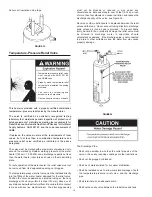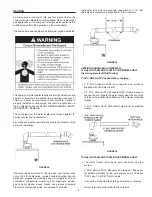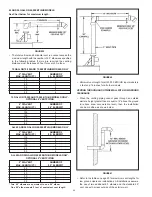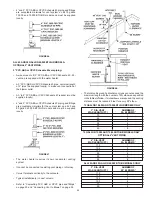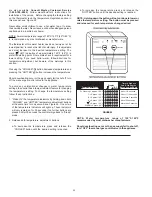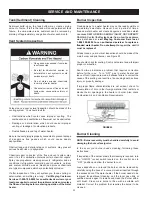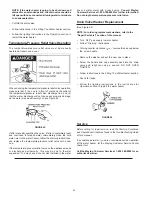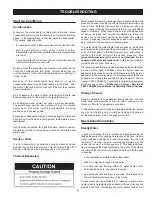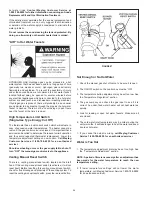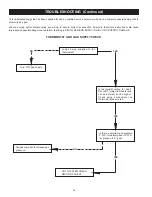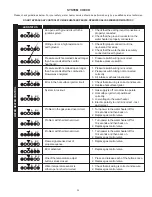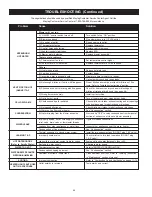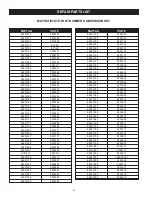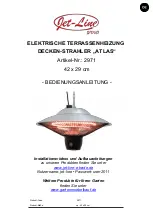
29
Operating
Propane gas is heavier than air. Should there be a leak in the
system, the gas will settle near the ground. Basements, crawl
spaces, skirted areas under manufactured (mobile) homes
(even when ventilated), closets and areas below ground level
will serve as pockets for the accumulated gas in the area.
Search for odor of gas by sniffing at ground level in the vicinity
of the appliance. If odor is detected, follow steps indicated at
“For Your Safety” on the cover of this manual then leave the
premises.
Operating instructions are located on front of the water heater,
above or to the side of the gas control valve, see page 30.
CHECK FOR LEAKS
Be sure to check all your gas pipes for leaks before operating
your water heater. Use a soapy water solution, not a match or
open flame. Check the factory gas fittings when the main burner
is turned “ON”.
WATER HEATING IGNITION SEQUENCE
(Make sure gas and electric power are connected properly)
1. The ignition control module is powered and monitors the
system, waiting for a call for heat from the thermostat.
2. The thermostat calls for heat by reading a resistance value
within a given range directly proportional to water
temperature.
3. The control module:
a. Checks the pressure switch for an open circuit.
b. Energizes the blower.
c. Checks the pressure switch for a closed circuit to prove
draft.
d. Sends line voltage to the hot surface igniter with a
20-second warm up period.
e. Opens the gas valve and checks the sensing rod for flame.
4. The burner heats the water to the desired thermostat setting.
a. The resistance in the thermostat rises to the value
selected by the temperature control knob.
b. The control module closes the gas valve and 5 seconds
later, removes power from the blower.
5. Cycle is completed.
CONTROL SEQUENCE - HOT SURFACE DIRECT IGNITION
Pre-purge
5 sec.
HSI Warm-Up
20 sec.
Ignition Activation Period
4 sec.
Flame Recognition Period
1 sec.
Ignition Trial
4 sec.
Interpurge
5 sec.
Post-purge
5 sec.
Retries
2
Reset from lockout
1 hr.
Flame Sensing (Nominal)
HSI Off/Run Mode
4.0 µ VDC
Temperature Regulation
Short repeated heating cycles caused by small hot water uses
can cause temperatures at the point of use to exceed the
thermostat by up to 30
o
F. If you experience this type of use you
should consider using lower temperature settings to reduce
scald hazards.
Any water heater’s intended purpose is to heat water. Hot
water is needed for cleansing, cleaning, and sanitizing (bodies,
dishes, clothing). Untempered hot water can present a scald
hazard. Depending on the time element, and the people
involved (adults, children, elderly, infirm, etc.) scalding may occur
at different temperatures.
HOTTER WATER CAN SCALD: Water heaters are intended to
produce hot water. Water heated to a temperature which will
satisfy space heating, clothes washing, dish washing, and
other sanitizing needs can scald and permanently injure you
upon contact. Some people are more likely to be permanently
injured by hot water than others. These include the elderly,
children, the infirm, or physically/mentally handicapped. If
anyone using hot water in your home fits into one of these
groups or if there is a local code or state law requiring a certain
temperature water at the hot water tap, then you must take
special precautions. In addition to using the lowest possible
temperature setting that satisfies your hot water needs, a
means such as a mixing valve, shall be used at the hot water
taps used by these people or at the water heater. Mixing valves
are available at plumbing supply or hardware stores, see
Figure 8 on page 9 and Figure 21 on page 15. Valves for
reducing point of use temperature by mixing cold and hot water
Summary of Contents for HRN11240P
Page 3: ...3 SAFETY PRECAUTIONS ...
Page 45: ...45 NOTES ...
Page 46: ...46 NOTES ...
Page 47: ...47 NOTES ...


